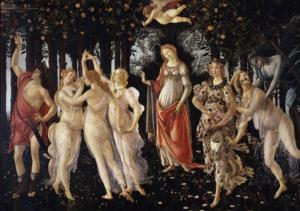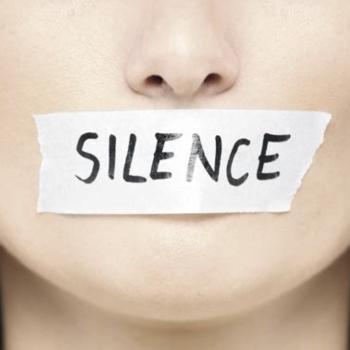No creature is concealed from him, but everything is naked and exposed to the eyes of him to whom we must render an account (Heb. 4:13).
“Clothing is meant to conceal a woman’s figure, not to reveal it.”
“Your choice of clothing at Mass demonstrates your respect for our Lord in the Blessed Sacrament.”
“Would you wear that if Jesus was right here in this room?”
I spent two decades of my life in the conservative Catholic bubble, where tropes like this are constantly bandied about, usually with the intent of shaming women into wearing high-necked, long-sleeved blouses, skirts to their ankles, and lace on their heads. Usually it’s the Blessed Virgin who is presented as the model of modesty for Catholic women—never mind the fact that our Lady once appeared wearing trousers and, on another occasion, ditched her veil.
Sometimes, what Jesus thinks of women’s dress is brought into the discussion. We hear about Our Lady of Fatima’s dire warning that there would be “certain fashions … introduced that will offend our Lord very much.” The assumption, naturally, is that the fashions that offend Jesus will be those worn by women. “Wifebeaters” that show off a man’s chest hair and ratty sweats that sag around his hips never seem to get any mention as offensive to our Lord’s presumably delicate sensibilities.
No one seems to question just how delicate our Lord’s sensibilities are though. When a woman called out to him from a crowd, saying, “Blessed is the womb that bore you, and the breasts that you sucked!” (Luke 11:27), St. Luke doesn’t report Jesus calling for his smelling salts or even reprimanding the woman for referring to his Mother’s breasts. Rather, Jesus answered, seemingly matter-of-factly, “Blessed rather are those who hear the word of God and keep it!” (Luke 11:28).
Then there was that time when the religious authorities brought a woman “caught in adultery” to Jesus (John 8:1–11). Many have wondered about the curious detail in the story that Jesus “bent down and wrote with his finger on the ground” (John 8:6, 8).
Years ago, a female speaker at an event I attended noted that perhaps the woman brought to Jesus was quite literally “caught in adultery” and dragged from the scene of her crime to Jesus. Perhaps the reason Jesus kept bending down and doodling in the sand was because the adulteress was nekkid. If so, Jesus may have been unwilling to look at an undressed woman, but neither did he seem particularly disturbed by her state of undress.
In this week’s second reading from the Letter to the Hebrews, we hear a perennial favorite of Bible-thumping Protestant Fundamentalists. “The word of God,” we’re told, “is living and effective, sharper than any two-edged sword, penetrating even between soul and spirit, joints and marrow, and able to discern reflections and thoughts of the heart” (Heb. 4:12). This verse is often pressed into service to substantiate sola scriptura—the idea that Scripture alone is the sole source of divine revelation and that Christians have no need of oral tradition or a divinely-appointed teaching authority.
The context of this verse though shows something quite different. In verse 13, we’re told that “no creature is concealed from him, but everything is naked and exposed to the eyes of him to whom we must render an account” (emphasis added). “The word of God” referred to here isn’t a thing, such as a scroll of Scripture, but a person. And when we remember St. John’s prologue, referring to God the Son as the incarnate Word of God (John 1:1–14), then it’s apparent that the author of Hebrews is referring to Jesus as “the word.”
Which got me to thinking that perhaps achieving sanctification isn’t so much bound to concealing bare skin or the shape of our bodies, but to preparing ourselves to be exposed completely in the sight of God.
So, what does the Church teach about the Last Judgment? The Catechism of the Catholic Church states:
“In the presence of Christ, who is Truth itself, the truth of each man’s relationship with God will be laid bare. The Last Judgment will reveal even to its furthest consequences the good each person has done or failed to do during his earthly life” (CCC 1039).
Laid bare? You mean like getting nekkid in the sight of God?
Then there’s the very next paragraph, in which we’re informed that “The Last Judgment will reveal that God’s justice triumphs over all the injustices committed by his creatures and that God’s love is stronger than death” (CCC 1040, emphasis added).
Oh. So, when Jesus judges us, he’s not going to be checking to see if our necklines fall more than a few finger-widths beneath our throat and measuring how far our skirts reach past our knees? He’ll be more concerned with the injustices we’ve committed? We could be covered head to toe in fabric and still be naked in his sight if we’ve mistreated our fellow creatures?
I firmly believe that one reason so many people think Jesus is a prig is because they are the ones who are prigs. The people who mock a progressive image of Jesus, saying that our Lord was no “social justice warrior,” are the very same people who assume Jesus would start spitting fire at the sight of a woman in a bikini. Those who mutter about women showing up to Mass in trousers, heads uncovered, are the ones who believe they’re being “disrespected” by a lack of conformity to their expectations. But rather than own that they want everyone to dress for Mass to their specifications, they project their opinions onto Jesus.
But the Jesus of the Gospels, the one who we’ll meet on the last day, is no prig. We’ll be exposed in his sight, but what he’ll be looking at is how we’ve treated others, not how we’ve dressed for others.
And the Jesus of the Letter to the Hebrews, who penetrates beneath the surface of our lives and judges us based on our deeds? Perhaps it’s no coincidence that there has been some speculation that the anonymous author of that letter was St. Priscilla, the Jewish woman who tutored Apollos in “the way of God” (Acts 18:26) and whom Paul praised, along with her husband, as “my fellow workers in Christ Jesus” (Rom. 16:3).
Michelle Arnold was a staff apologist for Catholic Answers, a Catholic apologetics apostolate in the Diocese of San Diego, California, from 2003–2020, answering questions from clients about the Catholic faith via phone, letter, email, and online platforms. She contributed essays to Catholic Answers’ online and print magazines, and wrote four booklets for the apostolate’s 20 Answers series. Her 20 Answers booklets were on Judaism, the New Age, witchcraft and the occult, and the Church’s liturgical year. Now a freelance writer, editor, and proofreader, Michelle Arnold has a blog at the Patheos Catholic channel. A portfolio of her published essays is available at Authory.













